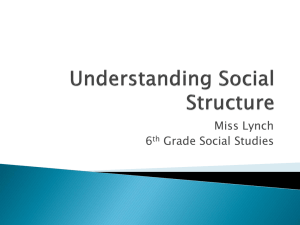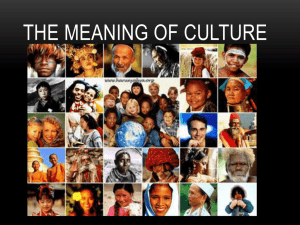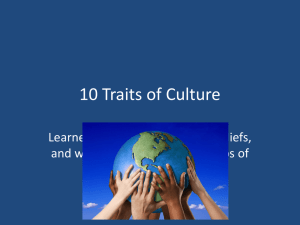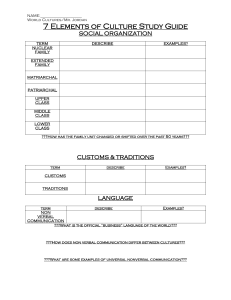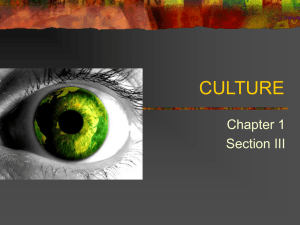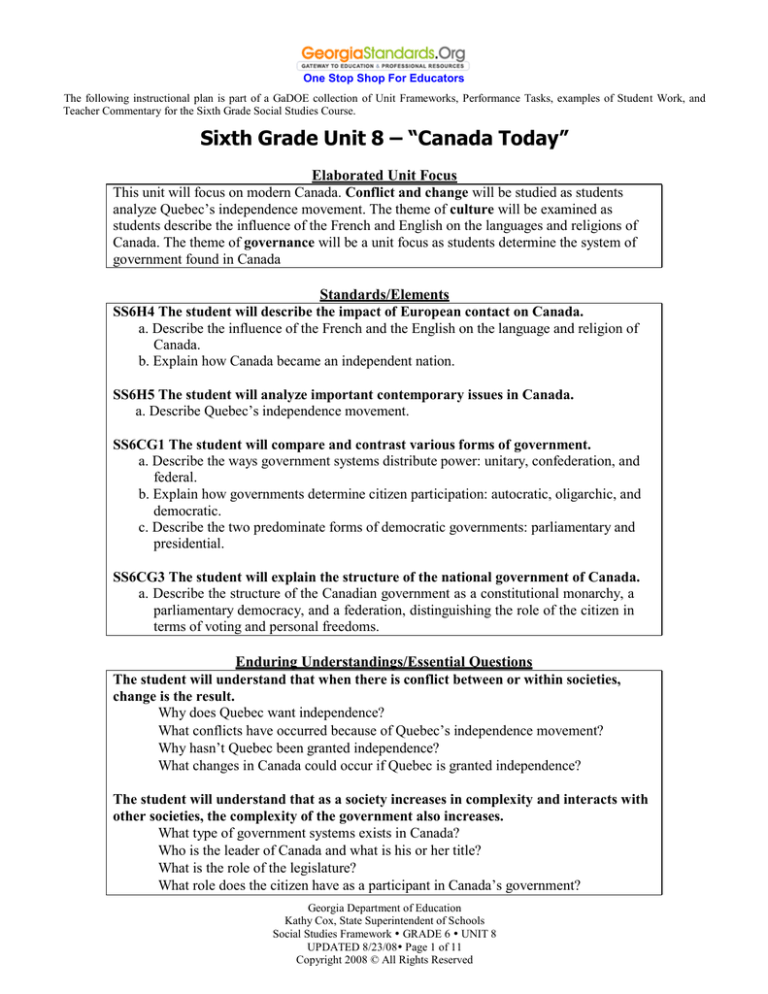
One Stop Shop For Educators
The following instructional plan is part of a GaDOE collection of Unit Frameworks, Performance Tasks, examples of Student Work, and
Teacher Commentary for the Sixth Grade Social Studies Course.
Sixth Grade Unit 8 – “Canada Today”
Elaborated Unit Focus
This unit will focus on modern Canada. Conflict and change will be studied as students
analyze Quebec’s independence movement. The theme of culture will be examined as
students describe the influence of the French and English on the languages and religions of
Canada. The theme of governance will be a unit focus as students determine the system of
government found in Canada
Standards/Elements
SS6H4 The student will describe the impact of European contact on Canada.
a. Describe the influence of the French and the English on the language and religion of
Canada.
b. Explain how Canada became an independent nation.
SS6H5 The student will analyze important contemporary issues in Canada.
a. Describe Quebec’s independence movement.
SS6CG1 The student will compare and contrast various forms of government.
a. Describe the ways government systems distribute power: unitary, confederation, and
federal.
b. Explain how governments determine citizen participation: autocratic, oligarchic, and
democratic.
c. Describe the two predominate forms of democratic governments: parliamentary and
presidential.
SS6CG3 The student will explain the structure of the national government of Canada.
a. Describe the structure of the Canadian government as a constitutional monarchy, a
parliamentary democracy, and a federation, distinguishing the role of the citizen in
terms of voting and personal freedoms.
Enduring Understandings/Essential Questions
The student will understand that when there is conflict between or within societies,
change is the result.
Why does Quebec want independence?
What conflicts have occurred because of Quebec’s independence movement?
Why hasn’t Quebec been granted independence?
What changes in Canada could occur if Quebec is granted independence?
The student will understand that as a society increases in complexity and interacts with
other societies, the complexity of the government also increases.
What type of government systems exists in Canada?
Who is the leader of Canada and what is his or her title?
What is the role of the legislature?
What role does the citizen have as a participant in Canada’s government?
Georgia Department of Education
Kathy Cox, State Superintendent of Schools
Social Studies Framework GRADE 6 UNIT 8
UPDATED 8/23/08 Page 1 of 11
Copyright 2008 © All Rights Reserved
One Stop Shop For Educators
The student will understand that the culture of a society is the product of the religion,
beliefs, customs, traditions, and government of that society.
How have the French and English influenced the languages and religions of Canada?
*Note: Evidence for student mastery of standards should include a balance of selected response, essay,
performance assessment or communication-based assessment yielding clear evidence for mastery of state standards.
(Rick Stiggins, 2004)
Georgia Department of Education
Kathy Cox, State Superintendent of Schools
Social Studies Framework GRADE 6 UNIT 8
UPDATED 8/23/08 Page 2 of 11
Copyright 2008 © All Rights Reserved
One Stop Shop For Educators
*NOTE: The balanced assessment plan included in this unit is presented as a series of suggested activities. It is not
expected that the teacher complete all assessments for a successful unit.
Balanced Assessment Plan
Description of Assessment
Standard/
Element
The teacher gives background knowledge of the Quebec
SS6H5a
independence movement.
http://www.quebecoislibre.org/020511-10.htm
Type of Assessment
*Constructed
Response
*Dialogue/Discussion
After a class discussion about the pros and cons of
independence for Quebec, the students will write a letter to the
editor of a Canadian newspaper. Students will express their
opinions on whether Quebec should be independent or not.
Students should include reasons for their opinion as well as
background information regarding the independence
movement. Conflicts which have existed between the Frenchspeaking and English-speaking residents regarding
independence should be included.
The teacher will provide information about the government of
Canada using resources in the classroom as well as the student
text. The students will then complete the graphic organizer
If this generic standard that review forms of government has
not yet been taught, it is STRONGLY recommended that this
activity be used in this unit:
Students will be divided into groups focused on the following
topics: (1) How governments distribute power, (2) How
citizens participate in government, and (3) Main forms of
democratic governments. Student groups will conduct
research on the ways in which governments (unitary,
confederation, federal) distribute power, how citizens
participate in government (autocratic, oligarchic, and
democratic), and forms of democratic government
(parliamentary and presidential). Student groups will give an
oral presentation (or participate in a debate), and record their
learning in a graphic organizer.
Students should complete an end of unit assessment which
may include matching, multiple choice, fill-in the blank, short
answer, and essay.
*Constructed
Response
*Dialogue/Discussion
*Observation
SS6CG1a,b,c Dialogue
Discussion
Observation
Self-Assessment
SS6CG3a
SS6H4a,b
SS6H5a
SS6CG1a,b,c
SS6CG3a
Georgia Department of Education
Kathy Cox, State Superintendent of Schools
Social Studies Framework GRADE 6 UNIT 8
UPDATED 8/23/08 Page 3 of 11
Copyright 2008 © All Rights Reserved
One Stop Shop For Educators
Sample Performance Task
CULTURE: The student will understand that the culture of a society is the product of the
religion, beliefs, customs, traditions, and government of that society.
MOVEMENT and MIGRATION: The student will understand that the movement or migration
of people and ideas affects all societies involved.
TIME, CHANGE, and CONTINUITY: The student will understand that while change occurs
over time, there is continuity to the basic structure of that society.
You will develop a cultural report of either French or British involvement in Canadian history
(from exploration to present times). Highlight traditions, customs, and religions of either the English or
French-speaking areas of Canada. Lastly, explain why Canada has two official languages, how Canada
became independent and why Quebec desires independence. The report should include each of the
following items and students should trace either the French or English involvement in Canadian
history.
Analyze French or English Canadian customs (practices) and explain how these practices
were shaped by the religion, beliefs, traditions, and government of that society.
Explain, in detail, how England or France colonized Canada. (Include: 1. The areas they
claimed, 2. The impact they made on Canada or what they hoped to acquire (other than land)
for their country.
Analyze continuing French and English conflicts in Canada. (Include: What tensions
developed between French and English Canadians in Quebec and what eventually came of this
conflict? How did the Quebec Act contribute to conflict between the English and French and
bring change.)
Analyze Canada’s journey towards national independence. (Include: 1. Tensions that
proceeded Canada becoming independent, 2. Two primary actions taken by British Parliament
to relieve tensions, 3. The British North America Act, and 4. Canada’s Independence and
Canada Day. 5. Analyze why nations want independence and are willing to go to war to gain
independence.
Map and Globe Skills:
6,7,8,11,12
Information Processing Skills:
2,3,5,6,7,9,11
Georgia Department of Education
Kathy Cox, State Superintendent of Schools
Social Studies Framework GRADE 6 UNIT 8
UPDATED 8/23/08 Page 4 of 11
Copyright 2008 © All Rights Reserved
One Stop Shop For Educators
*Note concerning rubrics: Each performance task is accompanied by two rubrics: a content rubric and a product rubric. The
content rubric is designed to measure how well a student can use the standards to demonstrate the enduring understanding(s).
The second rubric focuses on the product of the performance task. This is where students are scored on items involving
grammar, punctuation, spelling, creativity, presentation, etc. It is intended that the CONTENT rubric is weighed more heavily
when assigning a grade to the students.
Rubric for Performance Task
Content Rubric
Scale
Criteria
1
Below Standard
2 Needs Work
3
Meets Standard
4
Exceeds Standard
Does not accurately
Analyze modern
French or English analyze modern
Canadian customs customs.
(practices).
Accurately analyzes Accurately analyzes
modern customs and
modern customs.
explains how they were
shaped by the religion,
beliefs, traditions, and
government of that
society.
In addition to everything
in meets standard, also
draws correlations
between the French and
English Canadian
traditional practices and
modern customs.
Analyze French or Does not accurately
English Canadian analyze customs.
customs
(practices).
Accurately analyzes Accurately analyzes
customs.
customs and explains
how they were shaped
by the religion, beliefs,
traditions, and
government of that
society.
In addition to everything
in meets standard, also
draws correlations
between the French and
English Canadian
practices and customs.
Accurately identifies the
Identify the causes Does not accurately Accurately
identify
the
causes
or
identifies
the
causes
causes and explains the
and results of the
results.
or
results.
results.
escalation of
tensions between
French and
English Canadians
in Quebec.
In addition to everything
in “meets standard,” also
draws correlations
between the continual
conflicts between the
French and English
Canadians over land,
resources, power and
cultures today and
provides possible
solutions.
Analyze Canada’s Accurately analyze
less than two of the
journey towards
criteria.
national
independence.
In addition to everything
in “meets standard”; also
analyzes why nations
want independence and
are willing to go to war
to gain independence.
Accurately analyzes Accurately analyzes all
three of the criteria. four of the criteria.
Georgia Department of Education
Kathy Cox, State Superintendent of Schools
Social Studies Framework GRADE 6 UNIT 8
UPDATED 8/23/08 Page 5 of 11
Copyright 2008 © All Rights Reserved
One Stop Shop For Educators
Product Rubric
Scale
Criteria
Organization
Mechanics
1
Below Standard
Document is not
together in one piece,
illegible and missing
pages (such as the title
page or the table of
contents.
The text has more
than 10 spelling and
grammatical errors.
2 Needs Work
The report is in one
piece but is not
neatly written. The
document is missing
parts such as the title
page or the table of
contents.
3
Meets Standard
4
Exceeds Standard
The report is neatly
written or typed. Entire
document together in
one piece.
Report is neat and
legible. The report
includes a cover page.
A correct table of
contents is included.
Entire report is together
as one document.
The text has between The text has 1-5
6-10 spelling and
grammatical and
grammatical errors. spelling errors.
Georgia Department of Education
Kathy Cox, State Superintendent of Schools
Social Studies Framework GRADE 6 UNIT 8
UPDATED 8/23/08 Page 6 of 11
Copyright 2008 © All Rights Reserved
The text is free of
grammatical and
spelling errors.
One Stop Shop For Educators
Sample Performance Task
CONFLICT AND CHANGE: The student will understand that when there is conflict between or within
societies, change is the result.
CULTURE: The student will understand that the culture of a society is the product of the religion, beliefs,
customs, traditions, and government of that society.
HUMAN ENVIRONMENTAL INTERACTION: The student will understand that humans, their society,
and the environment affect each other.
LOCATION: The student will understand that location affects a society’s economy, culture, and
development.
MOVEMENT/MIGRATION: The student will understand that movement or migration of people and
ideas affects all societies involved.
TIME, CHANGE, CONTINUTY: The student will understand that while change occurs over time, there
is continuity to the basic structure of that society.
You have been asked to be a story teller at the elementary school near your middle school. The students there
are learning about the indigenous peoples of Canada and would like to have a comparison to people in other
parts of the world that have been studied this year (Latin America and the Caribbean). The sixth grade students
with the most informative and interesting stories will be invited to tell their story at the elementary school. You
may present your story as an illustrated story book, a documentary movie, a cartoon script, Web page,
PowerPoint, Photo story, display board, or an oral story with pictures or artifacts that you show as you tell the
story. Your story must include the following elements of the indigenous people you select:
Their origin and where they live now
Their basic beliefs
Arts and traditions
Their encounters with the Europeans
How their lives were affected by European colonists
Problems they face today in the modern world
The most important factors in your presentation are the relationship to all of the themes/concepts listed above:
(CONFLICT AND CHANGE, CULTURE, HUMAN ENVIRONMENTAL INTERACTION, LOCATION,
MOVEMENT AND MIGRATION, and TIME, CHANGE, CONTINUITY.)
Your teacher may allow you to choose which cultural group to prepare for or they may assign you to one of
these cultural groups.
Map and Globe Skills:
Information Processing Skills:
1, 5, 6, 11, 15, 16
Georgia Department of Education
Kathy Cox, State Superintendent of Schools
Social Studies Framework GRADE 6 UNIT 8
UPDATED 8/23/08 Page 7 of 11
Copyright 2008 © All Rights Reserved
One Stop Shop For Educators
*Note concerning rubrics: Each performance task is accompanied by two rubrics: a content rubric and a product
rubric. The content rubric is designed to measure how well a student can use the standards to demonstrate the
enduring understanding(s). The second rubric focuses on the product of the performance task. This is where
students are scored on items involving grammar, punctuation, spelling, creativity, presentation, etc. It is intended
that the CONTENT rubric is weighed more heavily when assigning a grade to the students.
Content Rubric for Performance Task
Does Not Meet
Does not tell where
the group lives or
where they
originated.
Not There Yet
Describes where
the group lives now
OR where they are
from but not both.
Describes and
gives examples of
the cultural
beliefs and
traditions.
Describes the group’s
beliefs and traditions
without giving
specific examples.
Analyzes the
impact of
Europeans (i.e.
weapons and
diseases) on the
cultural group.
Describes the
historical events of
the arrival of the
Europeans without
describing the
conflict or the effects
on the populations.
Does not show how
conflict and change
has impacted the
culture.
Gives examples of
the group’s
traditions and
beliefs without
explaining there
meanings.
Explains the
conflict between
the Europeans and
the native group
without evaluating
the effects on the
populations.
Shows either
conflict or change
and its impact on
the culture.
Traces the origin
of the cultural
group.
Analyzes how the
culture group has
encountered
conflict which has
resulted in
change.
Meets
Describes where the
group is originally
from and how they
came to their current
location.
Describes the group’s
creation, stories, art,
music, and other
traditions giving
specific examples.
Exceeds
In addition to the
prior info the journey
is described with
details such as means
of transportation.
Provides multiple
examples for each
cultural belief and
tradition required to
meet expectation.
Explains the impact
of Europeans on the
culture groups and
uses statistics to
document the effects
on the population.
In addition to explain
population statistical
changes the story
compares the
experiences to other
indigenous groups in
the world.
As well as “meets
standard”: Compares
and contrasts the
changes made in the
culture group with
changes in other
culture groups that
have faced conflict in
their past.
As well as “meets
standard” Compares
and contrasts the
religion, beliefs,
customs, traditions
and government of
their group to another
cultural group.
As well as “meets
standard” Compares
and contrasts human
environmental
interaction of this
cultural group to
another cultural
group.
Shows examples of
conflicts experienced
by culture group and
how the society has
changed as a result of
those conflicts.
Analyzes how the
culture is a
product of their
religion, beliefs,
customs,
traditions and
government.
Does not show how
the culture is a
product of their
religion, beliefs,
customs, traditions
and government.
Shows that the
culture is a product
of their religion,
beliefs, customs,
traditions and
government, but
not all of them.
Shows that the
culture is a product of
their religion, beliefs,
customs, traditions
and government.
Understand how
the environment
and their culture
affect each other.
Does not show how
the environment and
their culture affect
each other.
Shows how the
environment
affects the culture
or how the culture
affects the
environment, but
not both.
Shows how the
environment and
their culture affect
each other.
Georgia Department of Education
Kathy Cox, State Superintendent of Schools
Social Studies Framework GRADE 6 UNIT 8
UPDATED 8/23/08 Page 8 of 11
Copyright 2008 © All Rights Reserved
One Stop Shop For Educators
Analyzes how
location has
impacted the
culture’s
development.
Does not show how
location has impacted
the culture’s
development.
Shows the location
of the culture, but
does not show the
impact.
Shows how location
has impacted the
culture’s
development.
Analyzes how the
movement and
migration of
people and ideas
have impacted the
culture.
Does not show how
movement and
migration of people
and ideas have
impacted the culture.
Shows movement
and migration, but
does not show
impact upon the
culture.
Shows how
movement and
migration of people
and ideas have
impacted the culture.
Analyzes how the
culture group has
adapted to change
over time yet in
some aspects
continues to
maintain
traditions through
time.
Does not show how
the culture has
adapted and changed
over time.
Shows time,
change and
continuity, but does
not show how it
has impacted the
culture.
Shows how time,
change and
continuity has
impacted the culture.
Georgia Department of Education
Kathy Cox, State Superintendent of Schools
Social Studies Framework GRADE 6 UNIT 8
UPDATED 8/23/08 Page 9 of 11
Copyright 2008 © All Rights Reserved
As well as “meets
standard” Compares
and contrasts the
location and impact
of this cultural group
to another.
As well as “meets
standard” Compares
and contrasts
movement and
migration of this
cultural group to
another or explains
how the movement
and migration of their
culture impacted
another culture.
As well as “meets
standard” Compares
and contrasts time,
change and continuity
of this cultural group
to another.
One Stop Shop For Educators
Product Rubric
Criteria
Students
produce a
product that is
attractive.
1
Below Expectation
Use of font, color,
graphics, effects, etc.,
but these often distract
from the presentation of
content.
2
Needs Improvement
Makes use of font,
color, graphics, effects,
etc., but occasionally
these detract from the
presentation of content.
Students
produce a
product that is
organized.
There was no clear or
logical organizational
structure, just lots of
facts.
Content is logically
organized for the most
part.
Students
produce a
product that
exhibits proper
mechanics.
More than 4 errors are
spelling or grammar.
Four misspellings
and/or grammatical
errors.
Scale
3
Meets Expectation
Makes good use of font,
color, graphics, effects
etc. to enhance the
presentation. A visual
representation of the
idea/innovation is
included.
Uses headings or
bulleted lists to
organize, but the overall
organization of topics
appears flawed.
Three or fewer
misspellings and/or
grammatical errors.
Resources for Unit
CIA World Fact book
Canada
Mini-lessons on Great Lakes topics - Teach GLIN
Great Lakes Questions and Answers – (Teach GLIN)
United Streaming Videos:
http://streaming.discoveryeducation.com/index.cfm
Canada: Land of Diversity
Geography of Canada
North America: Land and Resources
Natural Resources:
http://www.cln.org/subjects/can-geog_cur.html
Quebec- Independence Movement
http://www.quebecoislibre.org/020511-10.htm
.
Georgia Department of Education
Kathy Cox, State Superintendent of Schools
Social Studies Framework GRADE 6 UNIT 8
UPDATED 8/23/08 Page 10 of 11
Copyright 2008 © All Rights Reserved
4
Exceeds Expectation
Makes excellent use of
font, color, graphics,
effects, etc. to enhance
the presentation.
Content is well
organized using
headings or bulleted
lists to group related
material.
No misspellings or
grammatical errors.
One Stop Shop For Educators
Canada’s Government
Constitutional
Monarchy
Parliamentary
Democracy
Distribution of
Power
Role of the
Legislature
Role of the
Citizen in
selecting leaders
Level of personal
freedoms
Georgia Department of Education
Kathy Cox, State Superintendent of Schools
Social Studies Framework GRADE 6 UNIT 8
UPDATED 8/23/08 Page 11 of 11
Copyright 2008 © All Rights Reserved
Federation

